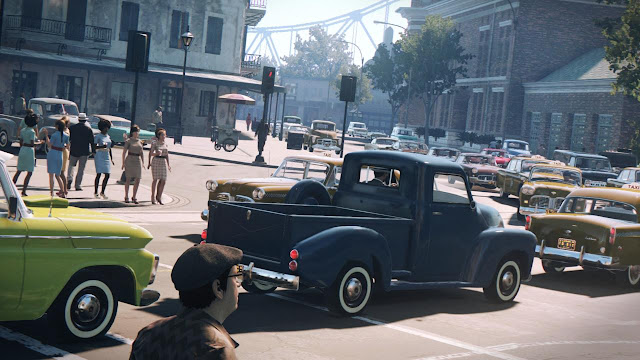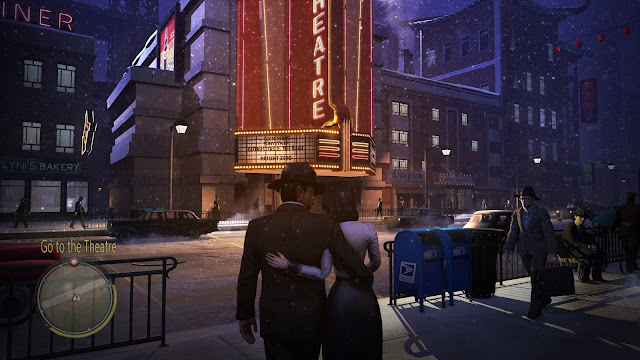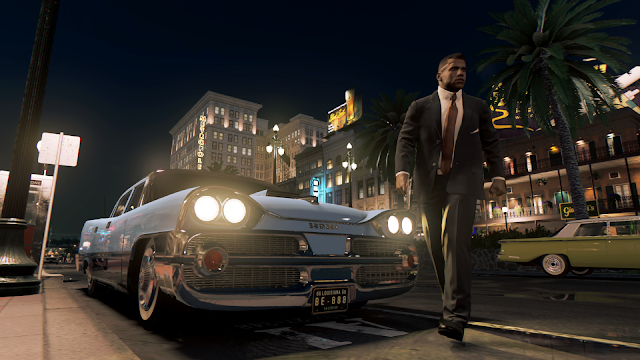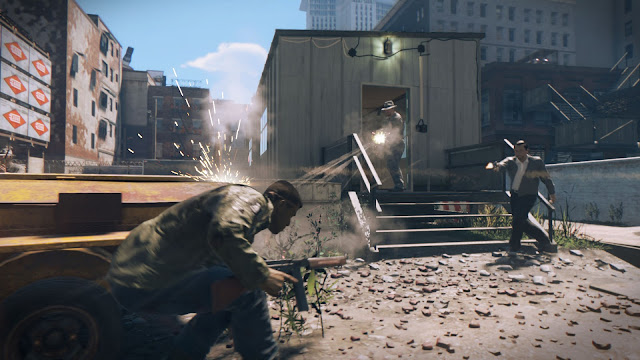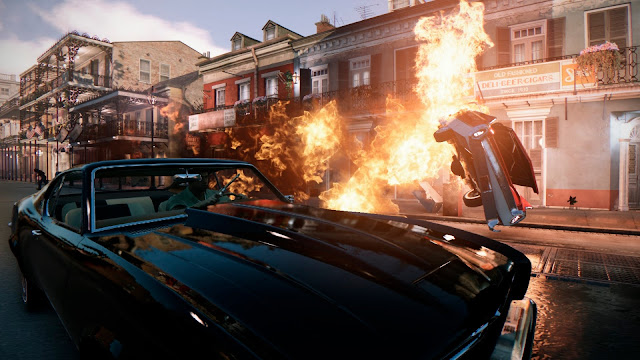Review by Harvard L.
With each copy of 2K and the development group behind Mafia 3 comes a pristine recreation of 1968 New Orleans. This is a city at a crossroads between the Civil Rights movement and the remnants of the Confederate Deep South; a city reverberating with freeform jazz, rhythm & blues and psychedelic rock and yet still marked by segregation, racial hate crime and a burgeoning black market run by warring organised crime factions. Now, couple that with a turbulent period in United States history, where the high profile assassinations of JFK and Martin Luther King, as well as the televised atrocities of the Vietnam War have roused the population into an almost apocalyptic fervour.
It’s a fascinating place to explore from a 21st Century perspective, since it’s easy to forget that while Jimi Hendrix recorded All Along the Watchtower, policemen were cracking down on racial enclaves for vices which in two years would become formalised as the US war on drugs. The developers have recreated a period of America with careful attention to both its beauty and its terror, spinning a morally grey narrative designed to challenge players on an emotional level.
Mafia 3 is Hangar 13’s first title, with assistance from studios including 2K Czech and Mass Media Games, and it’s a fully fledged open world one at that, so we were lenient when we assessed the game from a technical standpoint. Hangar 13 does have a lot of experience behind it, but taking on such a big name franchise with such an ambitious premise to boot, I thought it would be much more appropriate to sing the game’s praises rather than lambast its shortfalls. Every facet of the game from the narrative, the gameplay, the mechanics, the soundtrack and the overall feel are substantial, and while not perfect represent an earnest attempt to do things outside of the shadow of other open-world blockbusters like GTA. What makes Mafia 3 spectacular are the places where Hangar 13 and co went above and beyond to distance the game from the generic open world power fantasy to tell a story rarely explored in the gaming industry.
The dominant focus of Mafia 3 is definitely its protagonist, Lincoln Clay, a bi-racial orphan returning from service in the Vietnam War. As a child, Lincoln was taken in by Sammy, the leader of the black Mafia in Delray Hollow, and the only family Clay has ever known. The plot is set into motion when Sal Marcano, the leader of the Italian mob running the city, kills Sammy and shoots Lincoln, leaving him for dead. With the help of CIA informant John Donovan, Lincoln formulates a plan to win the support of local faction leaders to systematically kill and destroy all members of the Marcano criminal empire.
Clay is a complex character whose morality teeters between extreme yet justified, to just as depraved as the criminals he hunts. The plot is largely a foregone conclusion, told in documentary style through the perspective of an FBI officer investigating the life of Clay. In the intro alone, it’s clear that Clay succeeds in enacting his revenge, but the draw of the game’s narrative is not the observable plot – it’s in the murky details in between. Was Clay a hero? Did the war change him? How did he pull off heist after heist, eluding the retribution of both the mafia and the police force? And what end does he receive for his actions? As you play through the life of a notorious criminal the narrative positions you to keep reconsidering what you believe about morality, revenge and justice.
The story is carried by some truly impressive cutscenes, many of which are unique to the choices you take in the story. Well written dialogue is complemented by excellent voice acting to craft characters which are interesting and yet deeply flawed. It’s also good to see side characters and villains receive the same treatment of moral ambiguity. Cassandra, the Haitian faction leader, is untrusting and militaristic but believes in the liberation of her people and equal opportunity for Americans regardless of skin colour. Giorgi Marcano, the man who shoots Lincoln and sets the plot into motion, is friendly and fun-loving, even if his idea of fun is robbing banks and gunning down his enemies. Mafia 3 quickly developed a cast of characters I really cared about, and who were able to call me out when I acted against them, leading to some moments with real emotional weight.
Mafia 3’s vision of New Orleans, retitled as New Bordeaux, is indeed as much fantasy as it is grounded in history. The overall design aces the “feel” of New Orleans, dividing the game map into various districts with some focusing on business, industrial, nightlife, residential and an enormous bayou. There’s little repetition in the map and there are a surprisingly large number of buildings which are enterable, some of which have goodies hidden inside and also become crucial hiding spots once enemy mafia factions start ordering attacks against you. The map is decently sized at about 5km from one side to the other, though the lack of air vehicles or a quick travel feature makes it feel a lot larger than other open world games. Driving also feels amazing thanks to the tight controls, high variety in cars and excellent scenery.
World building also takes place in how New Bordeaux functions. The group of developers clearly set out to make a statement about racial politics in America with Mafia 3, and this shows in the clear racial divisions which occur between the boroughs of the city. In “white” areas of the city, some stores will explicitly forbid African American customers, and their owners will call the police on you if you don’t leave immediately when they spot you. NPC’s will respond to Clay differently – African American characters will cheerfully greet him while some white characters turn their heads and glare while you walk past them.
In fact, each borough has its own distinct demographic. Delray Hollow seems to be the haunt for Americans of dark skin, leading to an uneasy coexistence of African Americans and Haitian refugees. Verdun Pointe is for the Irish, the French Ward is largely inhabited by the Louisiana creoles and Downtown is populated by white businesspeople that hold power and resent the presence of other races. Whilst this has been explored in other open world games such as GTAV and LA Noire, never has it been so explicit, and Mafia 3 takes lengths to make the player feel the sting of racial discrimination. As a sidenote however, I was a bit disappointed at the game’s lack of representation of Asian characters; whilst the Vietnam War and Red China are large plot points, we don’t ever see a face attributed to these issues compared to the game’s treatment of other minorities.
Quite a few reviewers have questioned Hangar 13’s decision to make Mafia 3 an open world game when its mission structure and narrative would function better as a linear third person shooter. From a gameplay standpoint I agree with this; the vast majority of missions are standalone shootouts with some vehicular segments scattered throughout, and if you don’t care much for collectibles then there’s little to do in the world besides drive to the next mission. Enemy strongholds are also boxed in with only one or two entrances, which is contrary to the play-in-any-way-you-like approach favoured by the open world genre. From a narrative standpoint, however, being able to inhabit New Bordeaux gives the player extra time to identify with the setting and its characters. New Bordeaux is a city teeming with vices and it’s fascinating to watch how Lincoln acts both in support of and in rebellion to the city’s culture.
Mafia 3 bills itself as a shooter consistently through its promotional material, but I would say it is much better experienced as a narrative game. Make no mistake; nearly every main story mission is going to have you introducing enemy mobsters to the business end of a gun. Most players have expressed the shooting portion as sub-par, boring and unchallenging – a notion I would like to challenge: I would rather assess how the consistent the combat is with the story.
A key difference between Lincoln Clay and the protagonists of GTA, Saints Row or most other open world games is his motivation. Clay’s character is completely defined by the desire for revenge. Beset by post-traumatic stress disorder and a background in the psychological, guerrilla tactics of the Vietnam War, Clay does not enjoy killing or lawbreaking in the slightest, but also does not shy away from acts of violence, especially when doing so would fulfil his personal sense of duty. This reflects the character players embody in-game – they do not kill for the sake of killing, or for the power fantasy of being a celebrity criminal, but rather to advance the story and complete the cycle of revenge started by Sal’s betrayal. Each subsequent kill fuels Hangar 13’s vision of abnegation, rather than gratification.
Whilst the first criminal boss’s death is brutal and shocking, the impact gets lost the further you play into Lincoln’s story. The feeling is perhaps best expressed in a cutscene mid-game, where a character warns you that a constant exposure to violence makes a man numb to the emotional ramifications of killing. This poignant scene comes too little too late – whereas in the beginning I winced at the first time I accidentally killed a bystander, at this point I was complicit with shooting innocents, cops, anyone who got in my way of completing the mission. At the same time, the “villains” of the story are humanised as they react to Lincoln Clay, who is in their eyes the demonic figure who escaped a fatal bullet and a burning house, rising out of hell to indiscriminately murder clients, comrades and family alike. Hangar 13 crafts a compelling villainous protagonist, making a statement about the existence of evil and holding the player responsible for their criminal activity. Thus, the shooting is not fun and that’s precisely why I love it.
The game doesn’t offer a lot of distractions from Clay’s warpath either. There are no minigames or side-stories, and while there’s money to be earnt the only place you can spend it is at the weapons store. The game does allow you to explore the city and collect magazines – Playboy, Hot Rod and, ironically, Repent – which are all recreated and readable. My favourites were, embarrassingly, the Playboys; not for their nudity but rather for their insight into 60’s society – shedding light on the objectification of women and also, through interviews with leading figures, the cultural discourse at the time. I once spent a good 20 minutes reading a 15 page long interview with right-wing oil magnate H.L. Hunt as he decried communism and rallied in support of small government and big business. This was something I never would have done in my spare time, and I did because honestly I wanted to know more about the game’s setting. Mafia 3 is peppered with these moments of realism, from telephone wiretap conversations, news broadcasts on radio stations and conversations between characters who you are free to eavesdrop on.
Graphically, the game compensates for its middle ground visual fidelity with a keen eye for detail. Environments are designed to be eye catching and interesting, and you’ll start to recognise locations in New Bordeaux as if it were a real city. There are key setpiece moments in the game too, particularly in the showdowns with the Marcano family in the lategame, which are absolutely fantastic and jam packed with carefully choreographed action. I did notice a few missions glitching and objectives disappearing, but the game’s generous autosave feature meant I never lost my progress, and overall these and the visual errors are easy to patch up in the future. And the soundtrack – it’s absolutely perfect.
All these elements come together to create a rich portrait of 1960’s New Orleans. As you drive across high bridges across picturesque canals filled with alligators, while Eve of Destruction or Bad Moon Rising comes on the radio to foreshadow the hell you’re about to unleash upon a rival gang the second your car stops – when you manage to take in the light and the darkness of the city, that’s when the game truly hits its stride.
With its rich characterisation, documentary style focus and its unrelenting scrutiny of the darkness within American culture, Mafia 3 provides a thoughtful and at times confrontational experience which since now has been missing from the open-world genre. Hangar 13 has thoughtfully designed a tight experience where gameplay, atmosphere and narrative all contribute to an examination of character’s struggle with their society. It’s refreshing to see a game tackle hard issues so earnestly, and I can honestly say this is a story which will stay with me long after playing.
– Harvard L.
Contributor


